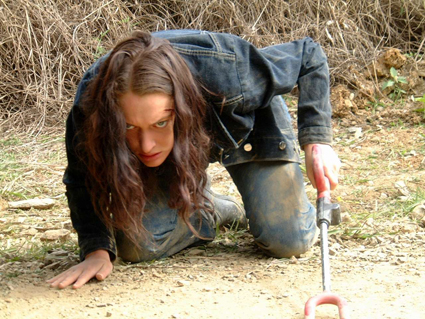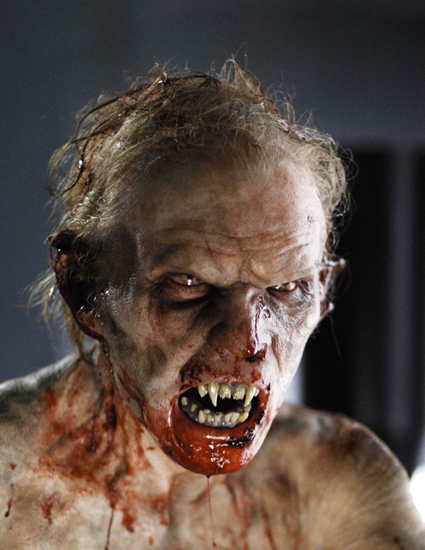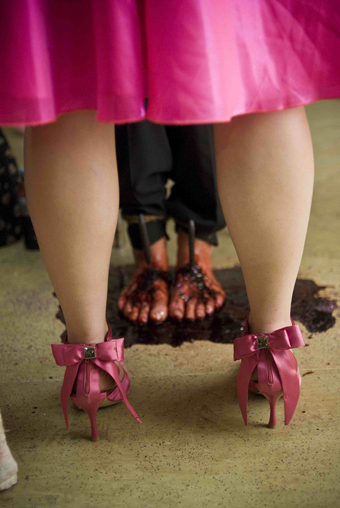the horror: how australian?
katerina sakkas: australian horror films, part two

Felicity Mason, The Undead
THIS ARTICLE CONTINUES TO EXAMINE THE CHARACTER OF NOTABLE FILMS FROM AUSTRALIA’S RECENT HORROR BOOM. PART ONE, IN REALTIME 103, FOCUSED ON SAW, WOLF CREEK, BLACK WATER AND INSIDIOUS. HERE I TURN TO OTHER FILMS THAT VARIOUSLY ENGAGE WITH AUSTRALIAN CHARACTER, LANDSCAPE, ACCENT AND MUSIC WHILE COMMITTING TO OR SUBVERTING GENRE FORMULA, OR BOTH.
undead
Like Saw creators James Wan and Leigh Whannell, the Spierig brothers are a young filmmaking duo whose hard work and hands-on commitment to the horror genre has paid off in terms of international success. Brisbane twins Michael and Peter Spierig, graduates in graphic design and film respectively, made about 20 short films together before pooling their savings to make Undead (2003).
Their interestingly flawed first feature displays visual flair, an eye for detail and an obvious love of genre film. The plot is generalised horror/sci-fi—a pastiche of spoof, zombie apocalypse, alien invasion, Western and heroic fantasy. The setting, however, sleepy fishing town Berkeley, is unabashedly Australian. Much attention is devoted to the creation of bucolic local colour. “Welcome to Berkeley,” reads a sign, “Come drop a line.” Protagonist René (Felicity Mason) has recently won the “Miss Catch of the Day” beauty pageant. There are shots of kids fishing, a local cricket match, agricultural life. The local fruit shop bears the legend, “Elvis Parsley’s Grapelands. Berkeley Fruit—Fit For the King.”
The local colour is extended to colourful locals, with a distinct ocker element that’s particularly embodied in the character of Harrison, a cop. This is amusingly juxtaposed with the film’s paranormal subject matter: “When I was a kid, we fuckin’ respected our parents,” Harrison barks, “we didn’t eat ‘em!” René, with whom the audience identifies, is the only character to escape caricature.

Daybreakers
courtesy Lionsgate Films
Daybreakers
daybreakers
Like Undead, Daybreakers (2009), the Spierigs’ more sophisticated (and bigger-budget) follow-up is visually adept, beginning with its introductory montage that sets the scene for a bleakly futuristic scenario. The brothers have once more turned to genre horror with a vampire film, but this one turns the tables: in the wake of an international plague, vampires have become the majority, the norm, while humans are a dwindling minority hunted down and harvested for their blood.
The vampires’ world is portrayed with elements of sci-fi noir à la Blade Runner (1982). The 1940s costume styling, moody lighting and cool blue tones contrast with the daytime world of the human survivors, whose warmth has a correspondingly bright, colour scheme that is recognisably Australian. Despite the cool stylisation, there’s some expertly timed gore, as when a vampire soldier testing a blood substitute explodes spectacularly. The film’s ultimate thrust is heroic, however, with a phoenix used to symbolise the resurgence of the human race.
Apart from Ethan Hawke and Willem Dafoe (playing an ethical vampire and human resistance fighter respectively) the cast is made up of well-known Antipodeans: Sam Neill, Claudia Karvan, Vince Colosimo, Isabel Lucas, Jay Laga’aia. But it seems that one of the vampire plague’s side effects is the acquisition of an American accent, for all that we appear to be on Australian territory. As Michael Spierig explained at a Popcorn Taxi Screening (www.popcorntaxi.tv/events/past/daybreakers-with-the-spierig-brothers/) this is the result of perceived financial necessity, where recouping a large budget means appealing to a ‘universal’ audience. Arguably, the film’s confused national identity makes its fantasy less convincing, especially to a local audience.
dying breed
Jody Dwyer’s 2008 film Dying Breed cannot be said to suffer from any such lack. Any discussion of recent Australian horror is incomplete without mention of this film, which bends over backwards to incorporate Australian history and Australian signifiers. As we follow four protagonists into the Tasmanian wilderness, we encounter spectacular scenery, Australian convict and cannibal history, meat pies (these last two not unrelated) and the tiger itself. Further Australian horror credentials are established with the casting of Saw’s Leigh Whannell and Wolf Creek’s Nathan Phillips in lead roles.
Despite the pronounced Aussie flavouring, the film follows the tenets of a certain American horror sub-genre which can roughly be described as ‘don’t mess with the locals,’ where holidaying urbanised outsiders fall prey to an insular, inbred community, as in Wes Craven’s The Hills Have Eyes (1977), Rob Zombie’s House of 1000 Corpses (2003) and the recent Resurrection County (2008). Such films often feature two young heterosexual couples driving into a natural location that is unfamiliar to them. In Dying Breed, Irish zoology student Nina (Mirrah Foulkes) is accompanied by Australian boyfriend Matt (Whannell), Matt’s crass mate Jack (Phillips) and the latter’s girlfriend Rebecca (Melanie Vallejo) in the search for the Tasmanian tiger that Nina’s sister was involved in at the time of her mysterious death. In keeping with the formula, the group encounters a ‘quaint’ community with a suspicious attitude towards outsiders. Over the course of the film, this will escalate into a bloodbath. Gender roles in this sub-genre are usually traditionally defined, with women tending towards hysteria while men take action.
Thus, Dying Breed follows a conventional overarching narrative, but remains enthusiastically Australian in its particulars. Though appearing appropriately dark and gothic, the wilderness is not imbued with menace in itself—the real threat resides in the community it harbours. The film’s horror comes out of this community’s adherence to tradition (a constantly reiterated theme) to family customs rooted in Tasmania’s dark history. Shackles and convict portraits are displayed in the primitive pub where the travellers find themselves. This community, we are about to discover, is descended from escaped convict-turned-cannibal Alexander Pearce, known as the “Pieman.” “The pies have hung on,” explains publican Harvey (Bille Brown) as the tourists dig into the local delicacy, “it’s important to us, tradition.”
Towards the end of the film, a clear analogy is drawn between the elusive Tasmanian Tiger and Pearce’s descendants: “Things have to stay hidden—to survive,” Harvey explains.

The Loved Ones
courtesy of Koch Media
The Loved Ones
the loved ones
Writer-director Sean Byrne’s first feature, The Loved Ones (2009), feels as authentically Australian as Dying Breed, but for different reasons. Despite its many American cinematic influences, notably Misery (1990), Carrie (1976) and Dazed and Confused (1993), Byrne’s approach to characterisation, his use of landscape and soundtrack all contribute to a sense of Australian identity. The film starts off in teen territory with a rejection in the lead-up to a country high-school dance. Recently bereaved Brent (Xavier Samuel) turns down quiet girl Lola’s invitation to the event. The latter, aided by her father, exacts a sadistic and prolonged revenge.
The exaggerated characters of Lola (Robin McLeavy) and ‘Daddy’ (John Brumpton) are reminiscent of the ‘quirky’ strain of well-known 90s Australian films: Strictly Ballroom (1992), Love Serenade (1996) and Priscilla: Queen of the Desert (1994). McLeavy’s impressive portrayal of Lola has affinities with Muriel in Muriel’s Wedding (1994): childishness, a girlish obsession with romance and weddings, outsider status and an exaggerated manner that’s endearing in Muriel; grotesque in Lola. The use of Kasey Chambers’ plaintive ditty “Am I Not Pretty Enough” as Lola’s theme is another Australian association. Underlining the motifs of adolescent unrequited love and the feminine fear of not measuring up physically, the song is played three times over the course of the film.
In her final scene, a bloodied Lola makes her steady, murderous way along a deserted road, singing Chambers’ song. Centre screen, she’s framed by the landscape, which accentuates her alienation and monstrosity. This image is an inversion of the similarly memorable scene from Greg McLean’s Wolf Creek (2005) where an injured Kristy attempts to escape along a deserted outback road. It’s one of The Loved Ones’ emblematic moments, encapsulating key narrative themes of loneliness, loss, warped femininity, violence and obsession.
enter the audience
While the Spierig brothers move into potential blockbuster territory with a 3D remake of The Dark Crystal (1982), two new Australian horror films are breaking ground by involving audiences in the filmmaking process via the internet. The Tunnel (2011) raised its modest 135K budget by pre-selling each of the film’s frames over the internet and on completion was released for free online. Upcoming office horror film Redd Inc. created a large online community by encouraging internet submissions of material—from performances to artwork—for inclusion onscreen. Interestingly, these two films also signal a shift away from the natural landscape towards an urbanised Australian horror, though it seems a safe bet that our open spaces will always have their place in the darker Australian cinematic consciousness.
RealTime issue #104 Aug-Sept 2011 pg. 34






